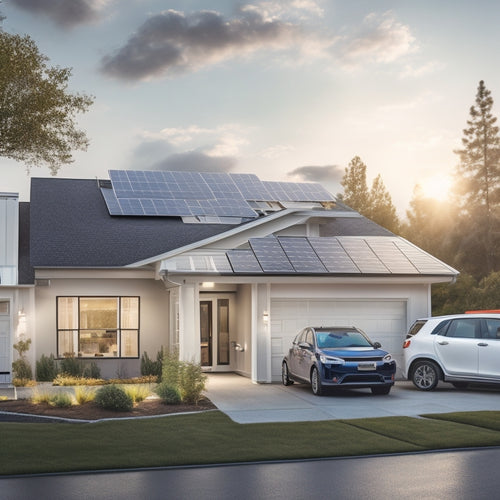
What's the Cost of Solar Panels in California Before Installation
Share
You can expect to pay between $15,000 and $30,000 or more for a standard solar panel system in California, depending on the brand, quality, and size of the system you choose. The cost breaks down to an average of $2.50 to $3.50 per watt, with budget-friendly options like Trina and Hanwha, and premium choices like Tesla and SunPower. Financing options and incentives, such as the federal solar investment tax credit, can help offset the cost. As you investigate your solar options, understanding the factors that impact cost, like system size and installation complexity, will be key to finding the best fit for your budget and energy needs.
Key Takeaways
- The cost of solar panels in California ranges from $15,000 to $30,000 or more for standard systems, depending on brand and size.
- Average cost per watt in California is between $2.50 to $3.50, making it a key metric for comparing different solar systems.
- Brand options include budget-friendly (Trina, Hanwha) and premium (Tesla, SunPower), significantly impacting overall cost.
- System size is a major factor, with larger systems increasing costs and smaller systems decreasing costs.
- Financing options are available, including loans and power purchase agreements (PPAs), some with $0 down payments for accessibility.
California Solar Panel Prices
You're likely wondering how much it'll cost to go solar in California, and rightfully so. The cost of solar panels in California varies depending on the type and quality of equipment you choose.
When it comes to solar panel brands, you've got options ranging from budget-friendly choices like Trina and Hanwha to premium brands like Tesla and SunPower.
Prices for a standard solar panel system in California can range from $15,000 to $30,000 or more, depending on the size of your system and the brand you choose.
However, with financing options available, going solar can be more affordable than you think. You can opt for a loan or a power purchase agreement (PPA), which allows you to pay for the electricity generated by your system rather than the system itself.
Some financing options even offer $0 down payments, making solar more accessible to homeowners.
Factors Affecting Solar Costs
Determining the cost of solar panels in California involves considering several factors that can greatly impact the final price tag. As you assess your options, it's crucial to understand how these factors influence the overall cost.
| Factor | Description | Impact on Cost |
|---|---|---|
| System Size | The number of solar panels needed to meet your energy needs | Larger systems increase cost, while smaller systems decrease it |
| Financing Options | Methods of paying for the solar panel system, such as loans or cash purchases | Financing options can add interest or fees to the total cost |
| Maintenance Expenses | Ongoing costs for repairing and replacing system components | Higher maintenance expenses increase the overall cost of ownership |
When evaluating solar panel costs, you should consider these factors to get an accurate estimate. For instance, a larger system size will require more materials and labor, increasing the cost. On the other hand, financing options can provide flexibility, but may add to the total cost. Maintenance expenses, although necessary, can also impact the long-term cost of owning a solar panel system. By understanding these factors, you can make an informed decision about investing in solar energy for your California home.
Average Cost per Watt
As you evaluate the factors affecting solar costs, it's helpful to look at the average cost per watt, a key metric in understanding the overall expense of a solar panel system. This metric represents the cost of each unit of power your system can produce. In California, the average cost per watt for solar panels ranges from $2.50 to $3.50.
When conducting a cost analysis for solar energy, understanding the average cost per watt is vital. It helps you compare different systems and determine which one provides the best value. A lower cost per watt generally indicates a more efficient system.
However, it's important to take into account other factors, such as the quality of the equipment and the installation company's reputation, to guarantee you're getting a reliable system that meets your energy needs.
As you investigate solar energy options, keep in mind that the average cost per watt can vary depending on the system's size, type, and brand. Be sure to research and compare prices from different providers to find the best option for your budget and energy requirements.
Installation Costs Breakdown
Breaking down the installation costs of your solar panel system can help you better understand where your money is going. As you prepare to switch to renewable energy, it's crucial to have a clear depiction of the expenses involved.
The installation costs of your solar panel system can be broadly categorized into two main components: installation materials and labor costs.
The installation materials account for a significant portion of the overall cost. This includes the solar panels themselves, inverters, mounting hardware, and other necessary equipment. The quality and efficiency of these materials can impact the system's performance and longevity.
On average, the installation materials can cost around $2.50 to $3.50 per watt, depending on the type and quality of the equipment.
Labor costs are another significant factor in the installation process. The cost of labor varies depending on the complexity of the installation, the location, and the installer's experience.
On average, labor costs can range from $0.50 to $1.50 per watt. Understanding these costs can help you make informed decisions about your solar panel system and facilitate a smooth installation process.
Incentives and Rebates Available
You're likely wondering how to offset the costs of your solar panel system. Fortunately, there are several incentives and rebates available to help reduce the financial burden.
The federal government offers a solar investment tax credit (ITC), which allows you to claim a credit of 26% of the total cost of your solar panel system. This credit can be claimed on your federal income taxes, providing a considerable reduction in your tax liability.
In addition to federal incentives, California also offers state rebates to encourage the adoption of solar energy. The California Public Utilities Commission (CPUC) provides a rebate of $0.20 per watt for residential solar panel systems, up to a maximum of $1,500.
This rebate is available to customers of participating utilities, including Pacific Gas and Electric (PG&E), Southern California Edison (SCE), and San Diego Gas & Electric (SDG&E).
Frequently Asked Questions
Do Solar Panels Increase My Property Value in California?
You'll be glad to know that solar panels can increase your property value in California, thanks to energy efficiency benefits and favorable property tax implications, making your home more attractive to potential buyers.
Will Solar Panels Affect My Roof's Warranty?
Like a precision-crafted puzzle, you're fitting the solar panel pieces together; now, you're wondering if installation will void your roof's warranty - rest easy, reputable installers will work with manufacturers to guarantee a seamless integration, preserving your roof warranty implications.
Can I Sell Excess Energy Back to the Grid?
You'll love the net metering benefits in California, where you can sell excess energy back to the grid and earn energy credits, which you can then use to offset your future energy bills, reducing your overall energy costs.
How Long Does a Typical Solar Panel Installation Take?
You'll be generating clean energy in no time, as the typical solar panel installation takes around 3-5 days for a residential setup, with the entire installation timeline spanning 2-3 months from permit to power-on.
Are There Any Maintenance Costs for Solar Panels?
You'll need to budget for occasional solar panel cleaning, typically $3-5 per panel, and inverter maintenance every 5-10 years, costing around $100-300, to guarantee peak performance and extend the system's lifespan.
Conclusion
You're considering going solar in California, and you're wondering what the costs are before installation. You might be thinking, "Isn't solar expensive?" But the truth is, solar prices have dropped considerably over the years, making it more accessible to homeowners like you. By understanding the costs and incentives, you can make an informed decision and start utilizing California's abundant sunshine to power your home.
Related Posts
-

What Electric Vehicle Owners Need for Home Energy
As an electric vehicle owner, you need to optimize your home energy system to guarantee efficient, sustainable, and c...
-

What You Need to Know About Permits and Inspections
You need to navigate the complex landscape of permits and inspections to guarantee your project complies with local z...
-

5 Ways Bike Sharing Boosts Urban Sustainability
As you explore bike-sharing options, you'll discover five ways it boosts urban sustainability. By reducing congestion...


